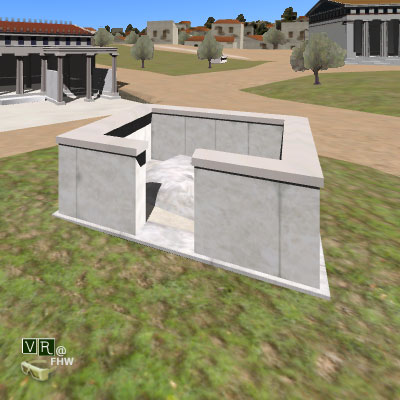Location: Northwest corner of the Agora. At the crossroads where the West Street meets with Panathenaic Way, opposite the Stoa of Zeus Eleutherios. Current position, inside the area of the modern Athens Subway. No. 26 in the plan of Agora in the Guide: Mc Camp II, J., The Athenian Agora, A Short Guide to the Excavations, Excavations of the Athenian Agora, Picture Book no 16, American School of Classical Studies, Princeton 2003, pp. 2 & 24-25. A better reconstruction can be found in Hesperia 44 (1973), p. 361.
Periods of Use: Classical
INTRODUCTION
This small road-side shrine of the Classical period, excavated in 1971-1972, was originally identified as the Leokoreion. Today this identification has been disputed. The shrine survives in a rather good condition: it consists of two stanchions surrounding a rock where passers-by placed their votive offerings. It was used until the late 4th cent. The nearby duct was in use during the Hellenistic period.
DESCRIPTION
The precinct survives in a very good condition, as it had been ‘sealed in’ the foundations of the 3rd cent. AD Roman building. It is roughly square, measuring 3.95 × 3.65m on the outside; it consists of slender orthostates of soft poros stone, 1.24m in height and 0.39m thick; these are supported on a low base, protruding by 0.06 to 0.10m. The wall enclosed the cult object, a jut in the natural rock. The dimensions of the stanchions vary: four make up the south wall, five the west and east, while just two particularly wide stanchions (1.10m) flank a slightly smaller one (0.92) on the north side. This last one, differing in thickness (0.44) from the rest, was added later to deny access through an opening which, at least according to the suggestion of the excavators, did not afford access to the area.
The posts might have been crowned by a marble fillet (band), although the view is that in some parts these survive in their original height. The band was removed while the shrine was still in use, for the upper part of the stones bears signs of wear from the elbows of the devotees leaning on the surrounding wall. The wall’s purpose was to stop the devotees from stepping into the sacred area. There is no access to the sacred area contained by the wall, this was an abaton. The visitors cast their offerings in the enclosed space and left them were they fell.
Some point in the late 5th cent. however, a floor of stamped ground was created covering the rock save its top, and it enclosed 5th cent. finds. During the late Classical period, the surrounding ground level rose to the top of the enclosure, which by now resembled a shallow quadrilateral well.
At a later time, in the late 4th cent. BC, the precinct was buried. At the same time, as indicated at least by the dating of the finds, the practice continued in a well dug 2.5m north of the abaton. The depth of the well reached 13.45m, and bore a stone wellhead in its upper part. At a second phase, when the ground level rose in the Agora, a second wellhead was added. Approximately 650 offerings were discovered in the well, dating from the 4th to the 2nd cent. BC.
The precinct's use
The finds from the area of the enclosure (mostly black-figure and red-figure ware), date to the third quarter of the 5th cent. (approx. 440 BC). There are no signs of an earlier cult. In all, 360 artefacts were discovered, most of them vessels: aryballoid lekythoi, kylikes, skyphoi, cups, choes, ‘yo-yos’, knitting-weights, astragaloi (knucklebones), gilt pebbles and jewellery. The main find is, of course, the head of a Hermaic stele discovered on the rock. After the levelling of the floor during the late 5th cent., the finds become sparser, and the latest are dated to the late 4th cent. Perhaps the offerings were periodically removed from the precinct and deposited in the nearby well. There are no inscriptions or a landmark of the shrine.
It has been suggested that we should identify it as the Leokoreion, the sanctuary in which the Athenians revered the daughters of Leos who were sacrificed to save the city from a pestilence or famine. This is where, according to Aristotle, Hipparchos was murdered by Harmodios and Aristogeiton in 514 BC. This last spot should be south after in some other part of the Agora.
The quality of the finds indicates possibly a female cult or the worship of a divinity common to men and women (Dionysus or Aphrodite?). Unpublished studies suggest a case of stone-worship related to Aphrodite.
The practice continued until the 2nd cent. BC, in the nearby well. It is unclear what happens in the following period, for during the Byzantine times the upper part of the well (5.34m in depth), was cleared and reused.
BIBLIOGRAPHY
BRONEER, O., “Notes on Three Athenian Cult Places”,
Αρχαιολογική Εφημερίς 1960, pp. 54-67 (especially 62-67).
EDMONSON, C.N., “The Leokoreion in Athens”,
Mnemosyne 17 (1964), pp. 375-378.
Mc CAMP II, J.,
The Athenian Agora: A Guide to the Excavation and Museum, 4th ed., Athens 1990. p. 86-87.
Mc CAMP II, J.,
The Athenian Agora: Excavations in the Heart of the Classical City², Cambridge University Press 2001, pp. 103-106.
SHEAR T.L. Jr., “The Athenian Agora: Excavations of 1971”,
Hesperia 44 (1973), pp. 121-179, tables 25-39 (esp. pp. 125-130, tables 25-28).
SHEAR, T.L., Jr., “The Athenian Agora: Excavations”,
Hesperia 44 (1973), pp. 359-407, table 65-76 (esp. pp. 360-369, table 65-67).
WYCHERLEY, R.E., “The Leokorion and Dyskolos 173”,
Mnemosyne 18 (1965), pp. 282-284.

Road-Side Shrine, Representation in VR environment

